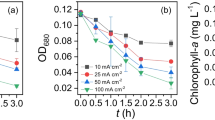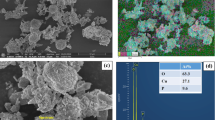Abstract
Electrooxidation is used to study the inhibition behavior of Microcystis aeruginosa, a dominant algae species during water blooms mainly caused by non-point source pollution. The inhibitory effect of current density, A/V ratio, initial algae concentration, and algae growth phase on the growth of algae by electrochemical oxidation was investigated, respectively. Further, the effect of electrolysis on the photosynthesis of algae cells and the degradation of Microcystin-LR (MC-LR) in solution were also studied. The results showed that the inhibitory effect increased with the increase of current density and A/V ratio. The damage of cell structure and the leakage of intracellular substances were observed when the current density was 17 mA/cm2. The intracellular chlorophyll a decreased significantly during the culture period. Only when the A/V ratio was 9.75 m−1, the algal growth could be completely inhibited. The inhibitory effect of algae was decreased with the increase of initial algal concentration, and the inhibitory effect of algae in the log growth phase was better than that in the stationary phase. The degradation efficiency of total MC-LR was 91.7% at 90 min. Some other substances could be degraded simultaneously along with the degradation of MC-LR in electrochemical oxidation.











Similar content being viewed by others
References
Christoffersen K, Kaas H (2000) Toxic cyanobacteria in water. A guide to their public health consequences, monitoring, and management. Limnol Oceanogr 45(5):255–258
Drogui P, Elmaleh S, Rumeau M, Bernard C, Rambaud A (2001) Oxidising and disinfecting by hydrogen peroxide produced in a two-electrode cell. Water Res 35(13):3235–3241
Gao S, Yang J, Tian J, Ma F, Tu G, Du MA (2010) Electro-coagulation–flotation process for algae removal. J Hazard Mater 177(1–3):336–343
Hu YY (2013) Experimental Research of the Low-power Ultrasonic Irradiation on the Growth of Algae. Dissertation, Chongqing University
Institute of Hydrobiology of Chinese Academy of Sciences. Determination of microcystins in water (GB/T 20466–2006), National Bureau of Quality Inspection
Jeon BS, Han J, Kim SK, Oh HC, Park HD (2015) The removal of Microcystis ichthyoblabe cells and its hepatotoxin microcystin-LR during electrooxidation process using Pt/Ti electrodes. J Environ Sci Health A 50(6):563–570
Jeong J, Kim C, Yoon J (2009) The effect of electrode material on the generation of oxidants and microbial inactivation in the electrochemical disinfection processes. Water Res 43(4):895–901
Lacasa E, Tsolaki E, Sbokou Z, Rodrigo MA, Mantzavinos D, Diamadopoulos E (2013) Electrochemical disinfection of simulated ballast water on conductive diamond electrodes. Chem Eng J 223:516–523
Liang WY, Qu JH, Chen LB, Liu HJ, Lei PJ (2005) Inactivation of Microcystis aeruginosa by continuous electrochemical cycling process in tube using Ti/RuO2 electrodes. J Environ Sci Technol 39(12):4633–4639
Liao W, Murugananthan M, Zhang Y (2014) Electrochemical degradation and mechanistic analysis of microcystin-LR at boron-doped diamond electrode. Chem Eng J 243(243):117–126
Mascia M, Vacca A, Palmas S (2013) Electrochemical treatment as a pre-oxidative step for algae removal using Chlorella vulgaris as a model organism and BDD anodes. Chem Eng J 219:512–519
Merel S, Walker D, Chicana R, Snyder S, Baurès E, Thomas O (2013) State of knowledge and concerns on cyanobacterial blooms and cyanotoxins. Environ Int 59:303–327
Murugananthan M, Latha SS, Raju GB, Yoshihara S (2011) Role of electrolyte on anodic mineralization of atenolol at boron doped diamond and Pt electrodes. Sep Purif Technol 79(1):56–62
Nan Y (2012) Study on the degradation of p-Nitrophenol and microcystin-LR wastewater by BDD electrode. Dissertation, Huazhong University of Science and Technology
Pacheco MJ, Santos V, Ciriaco L, Lopes A (2011) Electrochemical degradation of aromatic amines on BDD electrodes. J Hazard Mater 186(2–3):1033–1041
Patermarakis G, Fountoukidis E (1990) Disinfection of water by electrochemical treatment. Water Res 24(12):1491–1496
Petasne RG, Zika RG (1987) Fate of superoxide in coastal sea water.J. Nature 325(6104):516–518
Sivonen K, Evans WR, Carmichael WW et al (1996) Hepatotoxic microcystin diversity in cyanobacterial blooms collected in portuguese freshwaters. J Water Res 30(10):2377–2384
Songliao Basin Water Environment Monitoring Center, Water quality-determination chlorophyll by spectrophotometry (SL-88.2012), Standard of Ministry of Water Resource of People’s Republic of China
Tran N, Drogui P (2013) Electrochemical removal of microcystin-LR from aqueous solution in the presence of natural organic pollutants. J Environ Manag 114:253–260
Voloshko LN, Plyushch AV, Titova NN (2008) Toxins of cyanobacteria (Cyanophyta). Inter J Algae 10(1):14–33
Xu YF, Yang J, Ou MM, Wang YL, Jia JP (2007) Study of Microcystis aeruginosa inhibition by electrochemical method. Biochem Eng J 36(3):215–220
Zhang YR, Zhang Y, Yang N, Liao WJ, Sachio Y (2013) Electrochemical degradation and mechanistic analysis of microcystin-LR. J Chem Technol Biotechnol 88(8):1529–1537
Zhuo QF, Yang B, Deng SB, Huang J, Wang B, Yu G (2012) Electrochemical anodic materials used for degradation of organic pollutants. Prog Chem 24(4):628–636
Funding
Financial support by the 111 Project (No.B13041) and the Fundamental Research Funds for the Central Universities of China (No.106112015CDJXY210002) are acknowledged.
Author information
Authors and Affiliations
Corresponding author
Additional information
Responsible editor: Vitor Manuel Oliveira Vasconcelos
Rights and permissions
About this article
Cite this article
Wang, X., Xiang, P., Zhang, Y. et al. The inhibition of Microcystis aeruginos by electrochemical oxidation using boron-doped diamond electrode. Environ Sci Pollut Res 25, 20631–20639 (2018). https://doi.org/10.1007/s11356-018-1977-3
Received:
Accepted:
Published:
Issue Date:
DOI: https://doi.org/10.1007/s11356-018-1977-3




